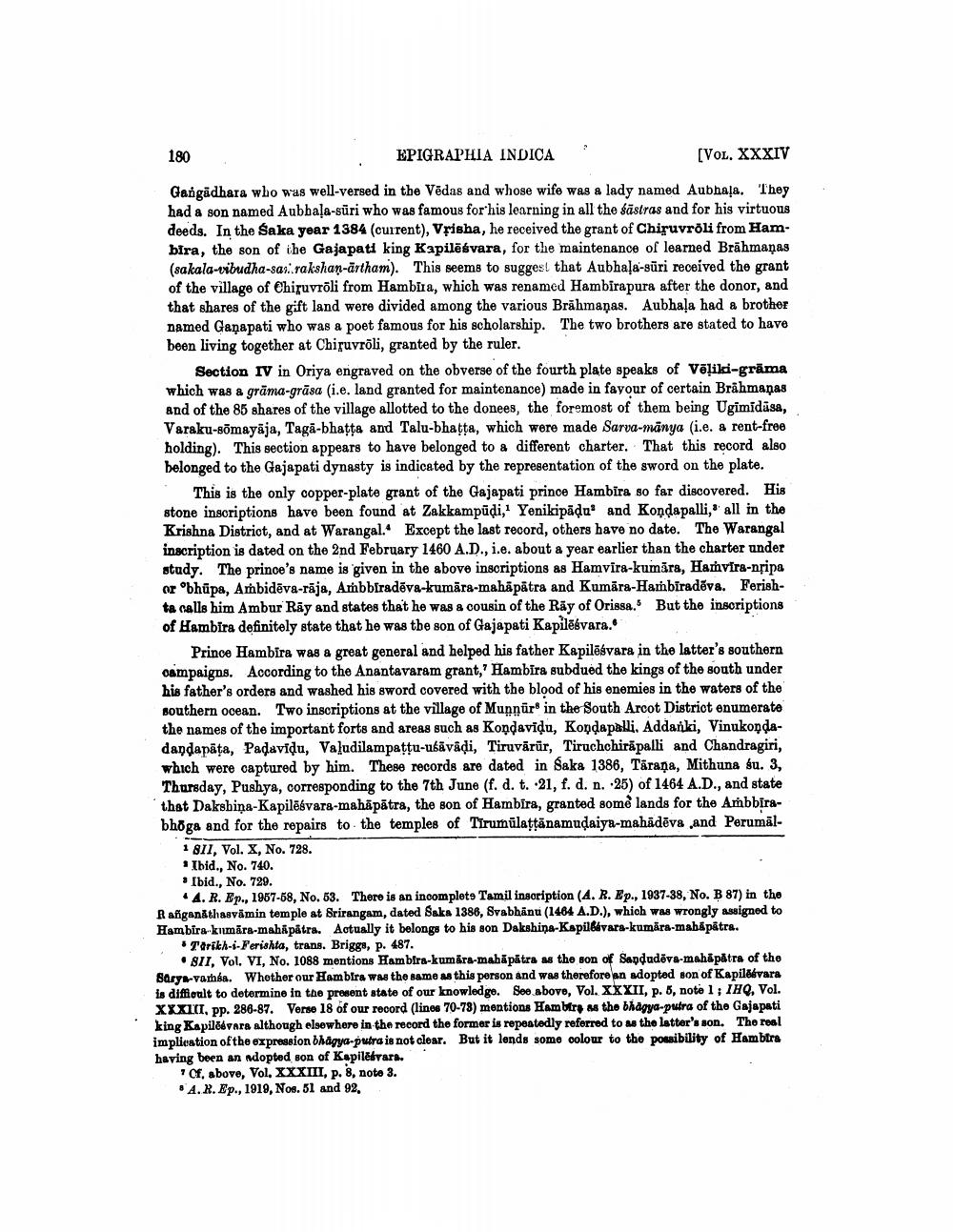________________
180
EPIGRAPHIA INDICA
[VOL. XXXIV
Gangadhara who was well-versed in the Vedas and whose wife was a lady named Aubhala. They had a son named Aubhala-süri who was famous for his learning in all the śästras and for his virtuous deeds. In the Saka year 1384 (current), Vrisha, he received the grant of Chiruvrōli from Hambira, the son of the Gajapati king Kapilēsvara, for the maintenance of learned Brāhmaṇas (sakala-vibudha-sas..rakshan-artham). This seems to suggest that Aubhala-süri received the grant of the village of Chiruvröli from Hambira, which was renamed Hambirapura after the donor, and that shares of the gift land were divided among the various Brahmaņas. Aubhala had a brother named Ganapati who was a poet famous for his scholarship. The two brothers are stated to have been living together at Chiruvrōli, granted by the ruler.
Section IV in Oriya engraved on the obverse of the fourth plate speaks of Veliki-grāma which was a grama-grāsa (i.e. land granted for maintenance) made in favour of certain Brahmanas and of the 85 shares of the village allotted to the donees, the foremost of them being Ugimīdāsa, Varaku-sōmayaja, Taga-bhaṭṭa and Talu-bhaṭṭa, which were made Sarva-manya (i.e. a rent-free holding). This section appears to have belonged to a different charter. That this record also belonged to the Gajapati dynasty is indicated by the representation of the sword on the plate.
This is the only copper-plate grant of the Gajapati prince Hambira so far discovered. His stone inscriptions have been found at Zakkampüdi, Yenikipadu and Kondapalli, all in the Krishna District, and at Warangal. Except the last record, others have no date. The Warangal inscription is dated on the 2nd February 1460 A.D., i.e. about a year earlier than the charter under study. The prince's name is given in the above inscriptions as Hamvira-kumāra, Hamvira-nṛipa or "bhupa, Ambidēva-raja, Ambbfradova-kumara-mahapatra and Kumara-Hambīradeva. Ferishta calls him Ambur Ray and states that he was a cousin of the Ray of Orissa. But the inscriptions of Hambira definitely state that he was the son of Gajapati Kapilēsvara.
Prince Hambira was a great general and helped his father Kapilēsvara in the latter's southern campaigns. According to the Anantavaram grant,' Hambira subdued the kings of the south under his father's orders and washed his sword covered with the blood of his enemies in the waters of the southern ocean. Two inscriptions at the village of Munnür in the South Arcot District enumerate the names of the important forts and areas such as Kondavidu, Kondapalli. Addanki, Vinukondadandapāta, Padavidu, Valudilampaṭṭu-usavaḍi, Tiruvarur, Tiruchchirapalli and Chandragiri, which were captured by him. These records are dated in Saka 1386, Taraṇa, Mithuna su. 3, Thursday, Pushya, corresponding to the 7th June (f. d. t. 21, f. d. n. 25) of 1464 A.D., and state that Dakshina-Kapilēsvara-mahapatra, the son of Hambira, granted some lands for the Ambbirabhoga and for the repairs to the temples of Tirumülaṭṭanamuḍaiya-mahādēva and Perumal1 811, Vol. X, No. 728.
Ibid., No. 740.
Ibid., No. 729.
A. R. Ep., 1957-58, No. 53. There is an incomplets Tamil inscription (4. R. Ep., 1937-38, No. B 87) in the Ranganathasvamin temple at Srirangam, dated Saka 1386, Svabhanu (1464 A.D.), which was wrongly assigned to Hambira kumara-mahapatra. Actually it belongs to his son Dakshina-Kapiléévara-kumara-mahāpātra.
Tarikh-i-Ferishta, trans. Briggs, p. 487.
SII, Vol. VI, No. 1088 mentions Hambira-kumara-mahāpātra as the son of Sandudova-mahapatra of the Sarya-vamhéa. Whether our Hambira was the same as this person and was therefore an adopted son of Kapilēévara is difficult to determine in the present state of our knowledge. See above, Vol. XXXII, p. 5, note 1; IHQ, Vol. XXXIII, pp. 286-87. Verse 18 of our record (lines 70-73) mentions Hambire as the bhagya-putra of the Gajapati king Kapiloévara although elsewhere in the record the former is repeatedly referred to as the latter's son. The real implication of the expression bhagya-putra is not clear. But it lends some colour to the possibility of Hambira having been an adopted son of Kapilēévara.
Cf, above, Vol. XXXIII, p. 8, note 3. A.R. Ep., 1919, Nos. 51 and 92,




